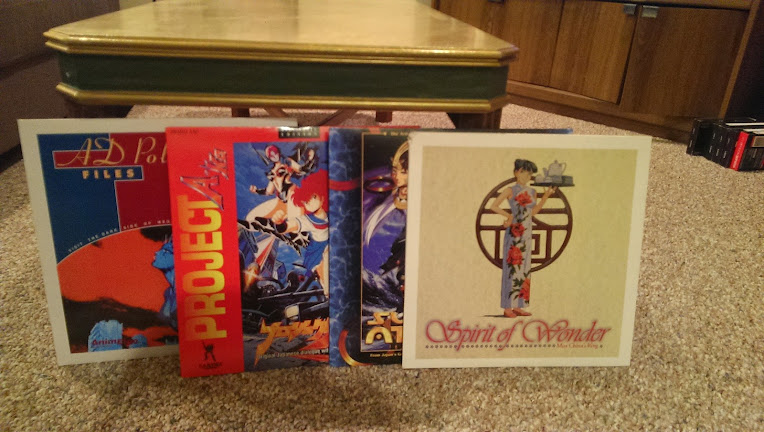greg wrote:I've got a question. Let's say, for example, that I did use some glass cleaner to clean a booger or something off an LD. Would Novus repair the finish to make it readable?
I would like to give you a definitive answer, but the best one I can think of is maybe. I've always been a pretty big cinephile outside of being a fan of anime/manga, so I have never actually applied a glass cleaner to one of my discs. BUT, I have repaired some pretty shoddy used ones that I've purchased, and a ton of CDs/DVDs for friends. I can tell you that LDs players are the pickiest pieces of hardware I have ever encountered, I've never ran into a CD or DVD that was scratched beyond repair with Novus and a dremel tool if you were using it in a decent player. With mildly scratched/damaged LDs, I'd say my success rate is about 50 % on ones with minor damage. I think the key would be if you just used that glass cleaner on a small spot, or gave the disc a complete wipe down for good measure. If you only used it on one small area, I'd say it can probably be saved. Obviously you only want to put Novus on the damaged area.
Here's how I repair discs with Novus:
1. NEVER use Novus #3 unless as a last resort, this is a sandy, gritty compound used for stripping clearcoat.
2. #1 is a cleaner/polisher, but will not do much for heavy scratches.
3. #2 can be used safely, but you have to be careful. A very small amount will be plenty. You will want to apply a coating of #1 on top of it after it has been applied and removed.
4. Use a soft, non-abrasive cloft. Again, make sure to go from the center out.
5. If using #2 and #1 doesn't fix it, you can try #3 before giving up. This would be more in regard to scratches, not stripping the outer coating like you have done with the glass cleaner. Again, you go in reverse order, use #3, #2, and then #1. You have to remove all of the #3 before applying #2. You then have to remove all of #2 before applying #1. You allow #1 ample time to set up, this is going to act as a new coating. So basically, Novus #3 is purely a stripping compound, #2 is both abrasive and fills in deeper cracks, and #1 creates a new replacement coating. The only one you do NOT wipe off completely is #1. You just apply the #1, and continue rubbing out from the center until it has been removed to the point of not being liquid, but just a visible coating, if that makes sense. Then allow time to set.
Also, if you have never used Novus before, I would recommend practicing on a junk cd. Just take some sandpaper or any rough object and mar up the surface of the disc on one side, and leave the other clean, that way you can compare the finish. If you get the hang of this you should be able to repair scratched LCD tvs/monitors, also.
Edit: Also, while I'm posting, I thought of a few more tips for people who don't have a lot of experience with LDs.
1. People often assume that S-Video is always the best default output. This is not necessarily the case. Only the really high end players are superior with S-Video, most mid-range players actually do the best output in standard composite. Make sure you try both to see which gives a clearer picture if you aren't sure with your player. Also, the quality of your cables is VERY important with analogue video, unlike with digital video. I personally recommend Monster brand cables, they are the ones that cinephiles usually recommend. Their S-Video and composite cables are getting hard to find though, but if you dig around on Amazon they tend to pop up from time to time. There are a bunch of knock off Mosnter cables out there as well, make sure you're getting the genuine ones before you buy.
2. Pretty much any LD made by Pioneer should be good quality and a fairly safe buy. Pioneer were the masters of LD, and actually handled the transfer for Criterion's LD releases as well.
3. If you plan to watch LDs on a newer, high defintion TV, you absolutely need to buy a good deinterlacer/scaler, and a good LD player. LD players have a huge disparity in terms of image quality, I wouldn't buy any player made before 1992 and would stick with Pioneer or Panasonic, preferably Pioneer. Don't buy combo LD/DVD units, and don't buy multi disc units (that could hold 2 or more LDs at once), these were of lower quality, even the ones made by Pioneer. The best scaler IMHO is the XRGB-3, for a variety of reasons, one being the high image quality and the other being the insane variety of outputs/inputs (SCART, VGA, Component, Composite, you name it). They run around $300, and come with Japanese firmware, but English firmware can be downloaded for them. It isn't the best ever made, but it is the most versatile, and will work with all of your older AV equipment and game consoles. Here's a good Youtube review:
http://www.youtube.com/watch?v=7JbpSlRhv2Q




